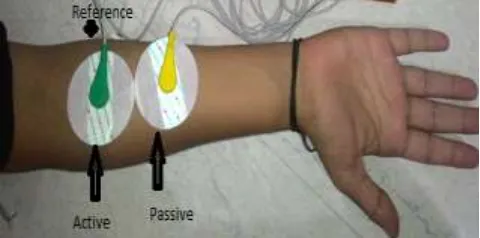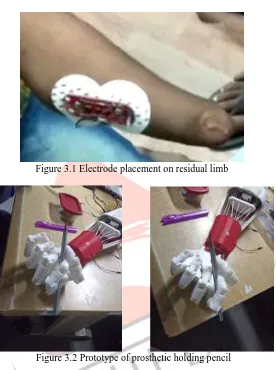IJEDR1803109
International Journal of Engineering Development and Research (
www.ijedr.org
)
658
Myo-Electric Hand : Prosthetic Hand Replication
Using EMG Based Approach
Practical implemented technique to bypass muscular signals recognized as sEMG to
prosthetic hand using controller to replicate degree of freedom to some extent since it is
the most effective way for people suffering from trans-radial amputees.
1Dinesh R. Damodar, 2Umang V. Suthar, 3Hemang D. Solanki 1Graduate Student, 2Graduate Student, 3Founder of HG Wellness
Gujarat Technological University, Gujarat Technological University, HG Wellness
_____________________________________________________________________________________________________
Abstract— This paper represents the exploratory research of simple, effective and low cost design of microcontroller based 3D prosthetic hand using a sEMG signals. A Myoelectric controlled prosthesis is an externally powered artificial limb that you control with the electrical signals generated naturally by your own muscles. The objective of the research is to design low cost myoelectric hand which utilize Myo-electric control. Surface EMG signals had been acquired from the residual limb of the hand, perform pre-processing task and featured extraction on EMG signals. The final output of sEMG signals applied through servo motor to the 3D Myo-electric hand. The hand will be able to help improve the quality of life of upper limb amputees. The Myo-electric artificial hand/arm does not require any unwieldy straps or harness to function. Although, it is custom made to fit and connect to the remaining limb. Myoelectric hand component perform better than conventional prosthesis in terms of function, weight, comfort and cosmetics. The mechatronic design of the prosthetic hand is inspired by the human muscle tendon system
Index Terms— Myoelectric hand, prosthetic hand, 3D printed hand, 3D prototype of hand, EMG signals, upper limb
amputee. Controlling prosthetic.
_____________________________________________________________________________________________________
1.INTRODUCTION
The primary purpose is to replace the function of a missing limb. While a single prosthetic that achieves both a natural appearance and extreme functionality would be ideal, most artificial limbs that exist today sacrifice some degree of one for the other. As such, there is a wide spectrum of specialized prosthetics that range from the purely cosmetic (which are inert) to the primarily functional (whose appearance is obviously mechanical). Myoelectric prosthetics are an attempt to serve both purposes of an artificial limb equally, without sacrificing appearance for functionality. Electromyography is the most common control interface for modern, upper limb prosthetics. Prosthetics that make use of EMG interfaces are commonly referred to as Myoelectric arms. The hands used in these devices are known as Myoelectric hands. The costs of commercially available Myoelectric hands are very high, ranging in price from 2 to 30 Lacs. Additionally, the repair of these hands usually requires expensive proprietary components and in almost all cases, a trained professional must conduct repairs.
Recognizing the need for an alternative to currently available technology for those with resources, we were able to develop a prototype hand with similar functionally to the more sophisticated Myoelectric hands on the market while reducing the cost of the hand to well below that of the most affordable Myoelectric hands that are currently available. Our team’s low-cost objective was achieved by developing an inexpensive EMG control platform and a mechanical hand that is designed to be produced inexpensively on a 3D printer. Our goal of achieving a high level of hand functionality was achieved by implementing a user interface that allows many more hand functions to be called by the user than current Myoelectric hand control systems.
Figure 1. Developed prototype of Myo-electric Hand
2.RESEARCH METHODOLOGY
IJEDR1803109
International Journal of Engineering Development and Research (
www.ijedr.org
)
659
amputee. This represents practical results achieved on many of impaired person revealing that easy to use and can be operate on patient.2.1 BLOCK DIAGRAM
Block Diagram illustrates the working mechanism and flow of Myo-electric hand. This Myoelectric hand controlled through sensors connected to remaining muscle of Patient’s arm. Sensors pick up EMG signals which are processed in arduino and converted to movements of prosthetic arm. Here the servo motors is used to control the individual finger movement of the artificial 3D designed and printed hand.
Figure 2.1 Block Diagram of Myoelectric Hand
2.2 ELECTRODES
Here we used surface electrodes which have crystal clear signal, ease of use and good grounding. This Disposable Adhesive Surface Electrode is designed with an Ag/AgCl sensing materials and an extra thick and flexible conductive gel. The electrodes, for recording, stimulation and ground use, are highly flexible and can be repositioned on all types of skin. The electrode is designed for patient comfort and user friendliness with soft wires and an optimized connector for easy insertion and extraction.
2.3 SENSING AND ACQUISITION OF SURFACE EMG SIGNALS
• As the nervous system always controls the muscular activities (contraction/relaxation), the EMG is used to diagnose diseases like neuropathies, neuromuscular junction diseases and myopathies.
• Myopathy is a muscle disease unrelated to any disorder of neuromuscular junction. Neuropathy is a collection of disorders that occurs when nerves of the peripheral nervous system (the part of the nervous system outside of the brain and spinal cord) are damaged. The EMG signal can be recorded or measured with an electrode, and is then displayed on an oscilloscope, which would then provide information about the ability of the muscle to respond to nerve stimuli based upon the presence, size and shape of the wave – the resulting action potential
• While the electrode could be inserted invasively into the muscle (needle electrodes), a skin surface electrode is often the preferred instrument, because it is placed directly on the skin surface above the muscle without employing the method of pinch insertion into the test subject. This project is a non-invasive method for measuring the EMG related diseases using surface electrodes. The point of interest of the signal is the amplitude, which can range between 0 to 10 millivolts (peak-to-peak) or 0 to 1.5 mill volts. The frequency of an EMG signal is between 0 to 500 Hz. However, the usable energy of EMG signal is dominant between 50-150 Hz.
2.4 ELECTRODE PLACEMENT
IJEDR1803109
International Journal of Engineering Development and Research (
www.ijedr.org
)
660
To acquire and analyze surface EMG signals we had first developed traditional circuitry and achieved result using placement of electrode as portrayed in figure. There total three electrodes placed on the different muscles as shown in Fig.2.2. For signal acquisition the upper amputee muscle is chosen where two electrodes – R (right) and L (left) have been placed. To obtain a reference point (the point with respect to that the potentials are being measured) a third electrode is placed at point G. Any movement of the muscle specifically contraction will generate an EMG signal as shown in Fig. 2.1(b), which can be sensed and acquired through electrodes.Figure 2.3 Generation of sEMG signals from the different movements of fingers
For different movements and for grasping the object of the Myo-electric arm two types of the muscle movements are considered - Flexion and Relaxation. From these movements several types of movement should be identified to control the motor. It has been observed that, different movements of flexor digitorum superficialis, flexor pollicis longus muscles can produce voltages with different levels. Initial portion of the graph portrayed with low amplitude graph revealing about passive motion in other sense when impaired person is steady and not trying to make any motion while in other portion increased amplitude are got at high position regarding to efforts of person to do some particular task or achieve some motion.
2.5 Muscle Sensor
Figure 2.4 Muscle sensor
In experiments signal acquisition sensor module is also used to acquire the sEMG signal due to the movement of superficial muscles. Acquired signals are processed, filtered and amplified to feed to an Arduino which in turn will produce the necessary driving pulses of the servo motors to replicating operation of the Myo-electric arm through designed algorithms. The design of the acquisition module are shown in Fig. 2.4
2.6 Microcontroller
IJEDR1803109
International Journal of Engineering Development and Research (
www.ijedr.org
)
661
2.7 Design and AspectsSolid modeling of the 10 unique hand components was performed in Auto Desk Inventor. The index, middle, ring and pinky fingers are each made up of a tip segment, a middle segment and a base segment, which is connected to the palm of the hand. The thumb is composed of just two segments but sits on a raised platform away from the palm, allowing it to directly oppose the other fingers when contracted. Detailed mechanical design was accomplished through the use of rough hand drawn sketches and Solid works CAD software provided by WPI. Individual parts were carefully modelled with as much detailed information and accurate dimensions as possible. When working with such limited space and small components, accuracy was a priority.
3. RESULTS AND DISCUSSION
Figure 3.1 Electrode placement on residual limb
Figure 3.2 Prototype of prosthetic holding pencil
Muscle Sensors are designed to be used directly with a microcontroller. Therefore, sensors primary output is not a RAW EMG signal but rather an amplified, rectified, and integrated signal (the EMG’s envelope) that will work well with a microcontroller’s analog-to-digital converter (ADC). This difference is illustrated below using a representative EMG signal.
Experiment was done on patient aged 14 years old child has been suffering from upper limb amputation since last four years. A muscle sensor has employed on the forearm stump in such a way it can give discrimination in output which is the primary necessity to operate this prosthetic. Movement of the prosthetic can be adjusted according to need of user. Here basic prototyping of pencil grasping has represented. This graph plots time versus amplitude frequencies of thumb, index and middle finger. The graph is showing two different activities of hand. Near to base line it indicates open hand and when amplitude goes high it shows closed hand.
The above elbow Myo-electric system is well suited for amputees such as salespersons, students, business people and professionals who are engaged in light work. The Myoelectric unit is not usually recommended for patients involved in heavy work such as farming or construction. These users, however, may find the Myo-electric unit appropriate as a secondary prosthesis. The Myoelectric system is more cosmetic than the conventional body-powered prosthesis. The cosmetic benefits make the Myo-electric prosthesis the overwhelming choice of our female patients. Without the harness control of the body-powered prosthesis, the Myo-electric controlled hand provides a greater range of motion, particularly when overhead motions are involved.
4. CONCLUSION
IJEDR1803109
International Journal of Engineering Development and Research (
www.ijedr.org
)
662
signals. Furthermore, we developed our own 3D printed arm prototype which can give different movements of fingers through Servo motor attached for individual fingers. Different finger movements are controlled and driven by using Arduino and Battery power supply. With our device one can see a better future for amputees by installing this type of Myo-electric hand which is comparatively affordable in cost into their physically handicapped persons.References
[1] Madeleine M. Lowery, Nikolay S. Stoykov, Allen Taflove, Todd A.Kuiken, “ A Multiple-layer Finite Element Model of the Surface EMG S ignal, “IEEE Transac tio n o n Biomedic al Engineering, vo l 49, no.5, May 2002, pp446-456.
[2] M. B. I. Reaz, M. S. Hussain and F. Mohd-Yasin, Biol. Pro-ced.2006“Techniques of EMG signal analysis: detection, processing, classification and applications”, 8(1):11–35.
[3] Richard F. ff. Weir, Ph.D., “Design of artificial arms and hands for prosthetic applications”
[4] J. G. Webster, “Medical Instrumentation: Application and Design”, 3rd. New York: Wiley, 98, pp. 121–182.


